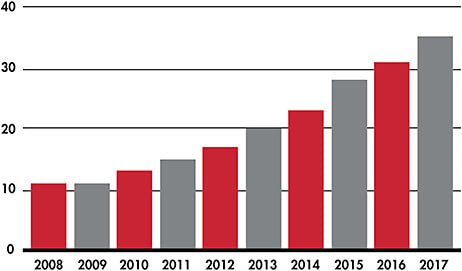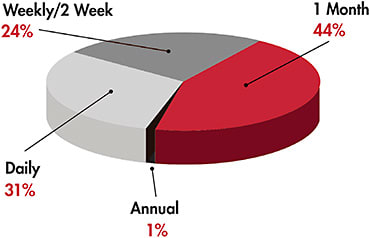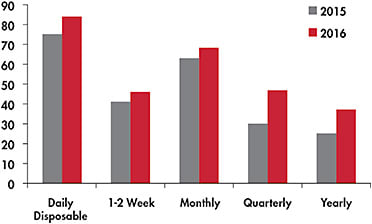Daily disposable contact lenses are a foundation for growth in the contact lens market for today and into the future. Over the past 10 years, daily disposable contact lenses have evolved and experienced tremendous growth in the U.S. market, with many new designs entering the category. Eyecare providers today are fortunate to have a multitude of innovative daily disposable lenses available in almost every visual category, including spherical, astigmatic, and presbyopic prescriptions. Let’s take a closer look at how this lens category has evolved over the last few years and what developments we may see in the near future.
PLENTY OF ROOM TO GROW
Daily disposable contact lens prescribing in the United States has increased every year for the past 10 years (Figure 1).1-10 The first year in which the percentage of daily disposable fits and refits surpassed that of weekly/two-week replacement lenses was 2015,8 and in 2016, the daily disposable category was the only category showing positive growth in percentage of fits and refits.9 In other words, daily disposable fits and refits were taking a large percentage from the monthly and weekly/two-week replacement categories. If you consider a product life cycle curve, which progresses from introduction to growth to maturity to decline,11 it is obvious that daily disposable lenses are in the growth section of the curve.

Daily disposable technology has also evolved over this time frame. In 2008, every manufacturer was looking to have at least one player in the market. At that time, eyecare professionals had about four different spherical daily disposables in standard hydrogel materials from which to choose. The one-day market has developed with time and innovation, and many new material entries in every design (spherical, toric, and multifocal) have arrived in the marketplace since. As the technology continues to evolve, the daily disposable segment looks promising for today and into the future.
DAILY DISPOSABLES TODAY
Comfort and moisture seem to be the hottest topics in today’s contact lens development. That may change in the future, but today’s manufacturers are looking for ways to increase the moisture levels that contact lenses can provide during the on-eye experience. In this digital world, conditions such as dryness, allergies, and fatigue can affect our ability to achieve good vision. Newer contact lenses feature technology that can help improve the ocular surface health by increasing and retaining moisture, decreasing eyelid/contact lens friction, and stabilizing the tear film. This not only provides better eyesight at multiple distances, but, most importantly, improves comfort during contact lens wear. This technology includes:
- New Materials In today’s daily disposable market, many manufacturers offer daily disposable lens options in at least two different materials. Often, one is a more traditional hydrogel material and the other is a newer, more advanced material. This is because as daily disposable lenses have gained in popularity and become more mainstream, they have become the platform for the majority of new contact lens launches in recent years; once manufacturers had hydrogel designs launched and moving in the marketplace, they turned their efforts to more advanced options.
Many newer daily disposable lenses are manufactured in silicone hydrogel materials. Silicone hydrogel reusable lenses had a positive impact on the contact lens industry when they were launched almost 20 years ago, and they have started making a bigger impact in the daily disposable category more recently. These lens materials are often designed to improve patients’ ocular health with increased oxygen permeability while also helping to improve comfort and vision. - New Designs After launching a spherical design, manufacturers often focus on developing a family of lenses in that lens material. This means that either a toric or a multifocal design will come next, depending on where manufacturers see the best opportunity.
I think that many eyecare providers see completing a lens family as an easy step, but many products take years to develop. For example, when developing a toric lens in a new material, a contact lens company’s research & development department will go through many different design challenges. Every lens material has its own unique relationship with the ocular surface and thus stabilizes on the eye differently. For toric lenses, it is important that they stabilize quickly, return to the exact same place every time, and not move once they stabilize. Once the best design is developed, then manufacturers need to determine how to make it on a large scale. This often requires a large investment in dollars and manufacturing technology development.
Once manufacturers have developed a material and launched all three designs (spherical, toric, and multifocal) in the core powers, their lens family is complete for the most part. Often, expanded parameters come at a later date. At the end of the journey, every manufacturer would like its lenses to be the first choice for every lens wearer. That is easier to achieve when the family of lenses is complete.
DON’T COMMODITIZE YOUR BRAND
There are many daily disposable options from which eyecare professionals can choose, and more regularly enter the market. A good strategy to employ is to convert as many patients as possible to standard daily disposable lenses initially, then look to upgrade those who need an advanced design. Find a way to make every contact lens examination unique. If you provide the same prescription to your patients year after year, you risk commoditizing your service and losing those patients.
Commodities are generally defined as products that have many substitutes in the marketplace. Practices that build brand loyalty are those that are continuously offering to their patients unique products and services that create value. New products, new materials, and new fitting modalities can help satisfy patients’ needs. Additionally, new fits or refits generate word of mouth referrals and revenue.
To avoid commoditizing your brand, dig a little deeper into your patients’ contact lens-wearing experience. Don’t accept “fine” as an answer from any patient. Build that practitioner-patient relationship by asking the extra questions. For example:
- “How do your contact lenses feel at the end of the day?”
- “How many comfortable wearing hours do you typically have?”
- “Are there any specific challenges that you have with your vision or comfort?”
After taking that deep dive, make the offer: “Did you know that there have been many new options launched in the daily disposable category? These innovative lenses often provide improved comfort and vision while you use a computer for long hours.”
Being innovative means staying ahead of the curve. Being an innovator usually comes with higher prices, but most consumers realize that the products are worth that added expense when the personal benefits are explained. Many companies look to upgrade and improve their products on a regular basis, and patients understand that. New and improved products and designs drive the market and create opportunities to improve our patients’ vision and their contact lens-wearing experience.
Additionally, being innovative means offering new lens designs, modalities, and materials to patients as they are introduced. Many patients present without complaints and are looking to “refill” their prescription. They are busy in their own world and really have no idea what is occurring in the world of contact lens technology. An innovative practice sees this as an opportunity to improve these patients’ experience with contact lenses, not just to “refill” their prescription. After continually making the offer to patients, they will eventually start asking what is new.
INCREASING YOUR DAILY DISPOSABLE LENS FITS
As a new lens enters the market, we need to find its home. Is it a workhorse lens that you would offer to everyone out of the gate? Is it a lens that you offer only to specific patients? With so many daily disposable options available now, it may seem a challenge to decide which lens to fit to a patient sitting in your chair.
It comes down to really understanding each patient’s visual needs. Patients often live in a visually demanding world and need a lens to match those visual needs. Many of the more premium daily disposable lenses have been designed to address some particular patient need, such as ultraviolet (UV) protection, aspheric optics, higher levels of oxygen, lower modulus, or increased level of moisture.
Know Your Numbers Take a look at your most recent monthly, quarterly, or yearly contact lens sales report. Look at your total daily disposable sales report. You need to understand your mix of standard and premium lenses. How high is your percentage of premium products such as silicone hydrogel, toric, and multifocal daily disposable lenses? Offering these options brings excitement and the perception of innovation to your patients. Look at the percentages for each company, and develop a strategy to introduce the products into your practice.
Start with Staff Education Taking an innovative approach to contact lenses starts with your staff. Once they understand how this new technology will benefit patients, they can be the first to plant the seed. “Mrs. Jones, did you know that we have the newest one-day disposable contact lenses in our office? Talk to the practitioner to see whether you are a candidate for this technology. We are having lots of success with this new lens!”
Create a Culture with Your Staff Around Presenting New, Innovative Products:
- When scheduling appointments, staff should make sure to mention contact lenses in some way. For example, for presbyopic patients, your staff could ask whether they are considering the new multifocal contact lenses to help with their near vision.
- During the appointment, a staff member can discuss how your office utilizes the newest technology in contact lenses that provide the most comfortable and clearest vision available.
- As the eyecare professional, follow through with the recommendation during the examination. Be proactive and upgrade patients’ vision. Offer the newest daily disposable spherical, toric, or multifocal lens that matches their visual needs.
- Set the stage for their next appointment. Your patients may love their current lenses and not be interested in a change this time. They may have never even worn contact lenses before. But either way, by having the discussion and making the offer, the stage has been set for the future.
Having a protocol and utilizing the whole office is critical to the success of a contact lens business. Not only can staff improve the efficiency with which we treat contact lens patients, but they also can improve the quality of care being provided.
Where Does Your Practice Stand with Daily Disposable Lenses Right Now? This evaluation starts with understanding your current business strategy. As I mentioned earlier, the average eyecare practice provided daily disposable lenses 15% of the time with all fits and refits in 2011 (Figure 2).4 Fast forward five years, and daily disposables had doubled to 31% in their utilization (Figure 3).9


Have you changed your fitting strategy over the past five years? Where are you along this product life cycle? Are you ahead or behind the curve? If you are behind, what steps can you take in your practice to change this? Make it your strategy and your philosophy to lead with daily disposables. In doing so, everyone wins. Patients win because daily disposable lenses are a more convenient and often safer and more comfortable product. The practice wins because daily disposable wearers are more compliant (Figure 4).9

WHAT DOES THE FUTURE HOLD?
Besides continuing to improve comfort and vision with newer lens materials, manufacturers are also developing innovative uses of contact lenses. I wish I could tell you specifically where the development is going, but all signs look positive for the daily disposable market. If I had my choice, these would be my top five new developments with daily disposable lenses:
- Continued Development and Improvement of Myopia Control Daily Disposable Designs Myopia control is becoming a more common discussion with parents and patients within our practices. Contact lenses designed for myopia control are most likely going to continue to evolve, and I expect them to be a mainstream product in the near future. Having the research and science help optimize these designs in a daily disposable lens will be an important development in eye care.
- Expanded and Improved Specialty Daily Disposable Designs Presbyopia is something that nearly every eyecare provider manages on a daily basis. The designs available today are successful, but I expect presbyopic contact lens designs to continue to evolve, perhaps to even include auto-focusing designs. There will also be new developments in toric-multifocal designs. Presbyopic astigmats currently do not have as many options to choose from with regard to contact lens wear, and there are not any daily disposable options for this category of patients.
- Drug Delivery Daily Disposable Designs Compliance and treatment outcomes for topically applied medications may be improved if a contact lens could deliver the appropriate amount of consistent medication release. This could be very beneficial for allergy sufferers, dry eye sufferers, and even glaucoma patients.
- Sun Lenses or Sports-Specific Daily Disposable Contact Lens Designs A contact lens that could darken when outside and block enough sunlight could gain traction in the marketplace. It would be nice to not have to carry around sunglasses. Additionally, perhaps even the availability of different tints for specific sports would be helpful. A recently announced reusable photochromic lens is coming in 2019, and there are currently reusable lenses in sports tints available; both would be more convenient and safer in a daily disposable modality.
- “Smart” Daily Disposable Designs Wearable technology, such as smart watches, seems to be gaining a lot of traction. Why not smart contact lenses? They could be used in a wide variety of areas, and this is a completely untapped area of development. For example, patents have already been secured on a contact lens technology that has a built-in camera. This camera would be controlled with a blink.
We have a long way to go. Who knows where the future in technology and vision takes us? Stay committed to being informed and offering the newest innovation to potential contact lens candidates. There is a bright future with daily disposable contact lenses. CLS
REFERENCES
- Nichols JJ. Contact Lenses 2008. Contact Lens Spectrum. 2009 Jan;24:26-34.
- Nichols JJ. Contact Lenses 2009. Contact Lens Spectrum. 2010 Jan;25:20-24, 26-27.
- Nichols JJ. Contact Lenses 2010. Contact Lens Spectrum. 2011 Jan;26:20-24, 26-27.
- Nichols JJ. Contact Lenses 2011. Contact Lens Spectrum. 2012 Jan;27:20-21, 23-25.
- Nichols JJ. Contact Lenses 2012. Contact Lens Spectrum. 2013 Jan;28:24-26, 28-29, 52.
- Nichols JJ. Contact Lenses 2013. Contact Lens Spectrum. 2014 Jan;29:22-23, 25, 26-28.
- Nichols JJ. Contact Lenses 2014. Contact Lens Spectrum. 2015 Jan;30:22-25, 27, 29.
- Nichols JJ. Contact Lenses 2015. Contact Lens Spectrum. 2016 Jan;31:18-23, 55.
- Nichols JJ. Contact Lenses 2016. Contact Lens Spectrum. 2017 Jan;32:22-25, 27, 29, 55.
- Nichols JJ. Contact Lenses 2017. Contact Lens Spectrum. 2018 Jan;33:20-25, 42.
- http://www.quickmba.com/marketing/product/lifecycle .




